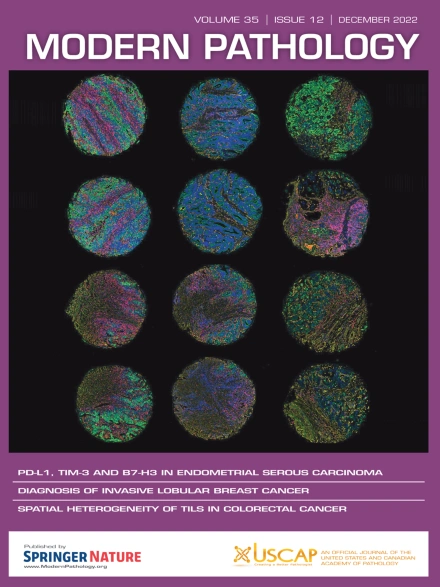MAD::NUT Fusion Sarcoma: A Sarcoma Class With NUTM1, NUTM2A, and NUTM2G Fusions and Possibly Distinctive Subtypes
IF 7.1
1区 医学
Q1 PATHOLOGY
引用次数: 0
Abstract
NUT fusion–associated cancers are heterogeneous and include NUT carcinoma and an emerging group with non-BRD4/BRD3/NSD3 fusion partners. In this study, we characterized 11 tumors harboring MAD::NUT fusions (10/11 in female patients; median age: 48 years; range: 1-67 years), all histologically different from NUT carcinoma. Eight cases were identified via sequencing database review and 3 were diagnosed prospectively. Eight (73%) patients presented with multifocal disease, including 6 with disseminated peritoneal tumors; 3 (27%) presented with solitary colonic, pulmonary, or orbital masses. Nine (82%) tumors harbored NUTM1 fusions, with MXI1 (5/9; 56%), MXD4 (2/9; 22%), and MGA (2/9; 22%). One tumor each harbored MXD4::NUTM2G and MXI1::NUTM2A fusions. The 9 MXD4/MXI1-rearranged sarcomas were high-grade, with epithelioid-to-spindle cell cytomorphology, amphophilic cytoplasm, vesicular nuclei, and prominent nucleoli. Histologic features included infiltrative growth (7/7 assessable tumors), rhabdoid morphology (7/9; 78%), prominent collagen (3/9; 33%), multinucleated tumor cells (2/9; 22%), and myxoid stroma (1/9; 11%). MXD4/MXI1-rearranged sarcomas expressed desmin (3/7; 43%) and keratin(s) (3/7; 43%), and not p63 (6 tumors), CD34 (5 tumors), or S-100 (5 tumors). The adult MGA::NUTM1 fusion sarcoma exhibited some cytologic overlap with MXD4/MXI1-rearranged sarcomas but showed lower grade myxoid spindle cell regions, microcystic spaces, and S-100 expression. The pediatric MGA::NUTM1 fusion sarcoma was low-grade with CD34/S-100 coexpression. Immunohistochemistry demonstrated NUTM1 expression in NUTM1-rearranged sarcomas (5/5), and weak and no expression in NUTM2A- and NUTM2G-rearranged sarcomas, respectively. Gene expression profiling demonstrated sarcomas with MXD4/MXI1::NUTM1/NUTM2A/NUTM2G fusions clustered separately from NUT carcinoma. Follow-up was available for 9 patients (82%; median length: 1.8 years; range: 2 months to 8.2 years). Four of 7 patients with MXD4/MXI1-rearranged sarcomas died of disease (median survival: 1.3 years; range: 5 months to 4.8 years), 1 entered hospice at 2 months, 1 was alive with pericardial masses at 2.8 years, and 1 was alive with no evidence of disease at 8.2 years. The adult with the MGA::NUTM1 fusion sarcoma died of other causes at 4.5 years; the child was alive without disease at 11 months. We conclude that MAD::NUT fusions define a sarcoma class distinct from NUT carcinoma. Among this group, MGA::NUTM1 fusion sarcomas might represent a distinctive subset. NUTM1 immunohistochemistry does not reliably detect NUTM2A/NUTM2G-rearranged sarcomas.
NUT-fusion肉瘤:一类具有NUTM1、NUTM2A和NUTM2G融合的肉瘤,可能有不同的亚型。
NUT融合相关的癌症是异质性的,包括NUT癌和一种新兴的非brd4 /BRD3/NSD3融合伴侣。在这里,我们鉴定了11个包含MAD:: nut融合的肿瘤(女性10/11;中位年龄:48岁;范围:1-67岁),均为组织学肉瘤。8例通过测序数据库审查确定,3例前瞻性诊断。8例患者(73%)表现为多灶性疾病,包括6例弥散性腹膜肿瘤;3例(27%)表现为孤立性结肠、肺或眼眶肿块。9例肿瘤(82%)存在NUTM1融合,MXI1 (5/9;56%), mxd4 (2/9;22%), MGA (2/9;22%)。MXI1::NUTM2A和MXD4::NUTM2G各1个肿瘤。9例MXD4/ mxi1重排肉瘤为高级别肉瘤,细胞形态为上皮样-梭形细胞,细胞质为两亲性,细胞核呈泡状,核仁突出。组织学特征包括浸润性生长(7/7可评估肿瘤),横纹肌样形态(7/9;78%),胶原蛋白突出(3/9;33%),多核肿瘤细胞(2/9;22%),粘液样间质(1/9,11%)。MXD4/ mxi1重排肉瘤表达desmin (3/7;43%),角蛋白(s) (3/7;43%),而不是p63(6例)、CD34(5例)或S-100(5例)。成人MGA:: nutm1融合肉瘤与MXD4/ mxi1重排肉瘤在细胞学上有一些重叠,但表现出较低级别的黏液样梭形细胞区、微囊性间隙和S-100表达。小儿MGA:: nutm1融合肉瘤为低级别,CD34/S-100共表达。免疫组化(IHC)结果显示,NUTM1在NUTM1重排肉瘤中表达(5/5),而在NUTM2A-和nutm2g重排肉瘤中表达较弱或不表达。基因表达谱显示MXD4/MXI1::NUTM1/NUTM2A/NUTM2G融合体与NUT癌分开聚集。9例患者(82%;中位数:1.8年;范围:2 -8.2年)。7例MXD4/ mxi重排肉瘤患者中有4例死于疾病(中位数:1.3年;范围:5岁至4.8岁),1例在2个月时进入临终关怀,1例在2.8岁时存在心包包块。MGA:: nutm1融合肉瘤患者在4.5岁时死于其他原因;孩子在11个月时存活,没有疾病。我们得出结论,MAD::NUT-融合定义了一种不同于NUT癌的肉瘤类型。在这一组中,MGA:: nutm1融合肉瘤可能代表了一个独特的子集。NUTM1 IHC不能可靠地检测出NUTM2A/ nutm2g重排肉瘤。
本文章由计算机程序翻译,如有差异,请以英文原文为准。
求助全文
约1分钟内获得全文
求助全文
来源期刊

Modern Pathology
医学-病理学
CiteScore
14.30
自引率
2.70%
发文量
174
审稿时长
18 days
期刊介绍:
Modern Pathology, an international journal under the ownership of The United States & Canadian Academy of Pathology (USCAP), serves as an authoritative platform for publishing top-tier clinical and translational research studies in pathology.
Original manuscripts are the primary focus of Modern Pathology, complemented by impactful editorials, reviews, and practice guidelines covering all facets of precision diagnostics in human pathology. The journal's scope includes advancements in molecular diagnostics and genomic classifications of diseases, breakthroughs in immune-oncology, computational science, applied bioinformatics, and digital pathology.
 求助内容:
求助内容: 应助结果提醒方式:
应助结果提醒方式:


